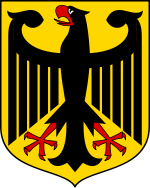Amt (country subdivision)
| Germany |
 This article is part of the series: |
|
|
|
Constitution
Legislature
Judiciary
Executive
Divisions
Elections
Foreign policy
|
|
Other countries · Atlas |
"Amt" is a type of administrative division of some northern European countries. It is generally larger than a municipality, and the term is thus roughly equivalent to a U.S. "township".
Contents |
The Amt in Germany
The Amt (plural, Ämter) is unique to the German Bundesländer (federal states) of Schleswig-Holstein, Mecklenburg-Western Pomerania and Brandenburg. Other German states had this subdivision in the past. Some states have similar administrative units called Samtgemeinde (Lower Saxony), Verbandsgemeinde (Rhineland-Palatinate) or Verwaltungsgemeinschaft (Baden-Württemberg, Bavaria, Saxony, Saxony-Anhalt, Thuringia).
An amt, as well as the other above-mentioned units, is subordinate to a district, and is subdivided into municipalities. The amt is lower than county-level government, but higher than municipal government, and may be described as a supra-municipality or "municipal confederation." Normally it consists of very small municipalities; larger municipalities do not belong to an amt, and are called "Amt-free municipalities" (amtsfreie Gemeinden).
The amt in Denmark
The amt (plural, amter; English, "County") was an administrative unit of Denmark (and, historically, of Denmark-Norway). The counties were established by royal decree in 1662 as replacements for the former Len (fiefs). The amter were originally composed of independent towns (købstæder) and parishes, and held only small areas of responsibility. During the 20th century, they were granted responsibility for the hospital service for the non-urban population. A 1970 administrative reform reduced the number of countries to fourteen and eliminated the administrative distinction between (rural) parish and town. From then on, the amter were composed of a number of municipalities (Danish: kommuner). The reform granted the counties wider areas of responsibility, most notably running the national health service and the gymnasium secondary schools.
The Danish Municipal Reform of January 1, 2007 abolished the amter and replaced them with five administrative regions, now solely charged with running the national health service. In contrast to the amter the regions hold no authority to levy taxes. The reform re-delegated all other areas of responsibility to either the municipalities or the state. At the same time, smaller municipalities were merged into larger units, cutting the number of municipalities from 270 to 98. See Counties of Denmark for more information about the Danish usage of the term.
The amt in the Netherlands and Flanders
Ambacht can be seen as Dutch equivalent to amt. Ambachten existed in Holland, Zeeland and Flanders up to about 1800.
The amt in Norway
From 1662 to 1919, the counties of Norway were called amter. They are now referred to as fylker.
|
||||||||||||||||||||